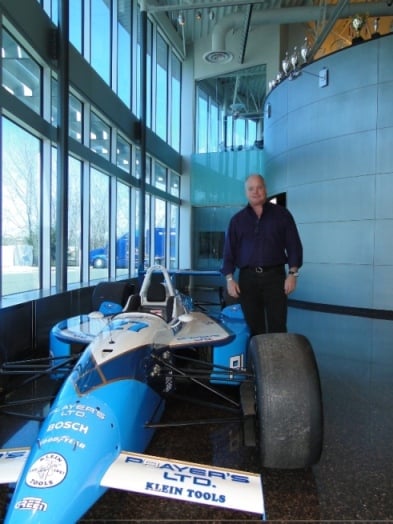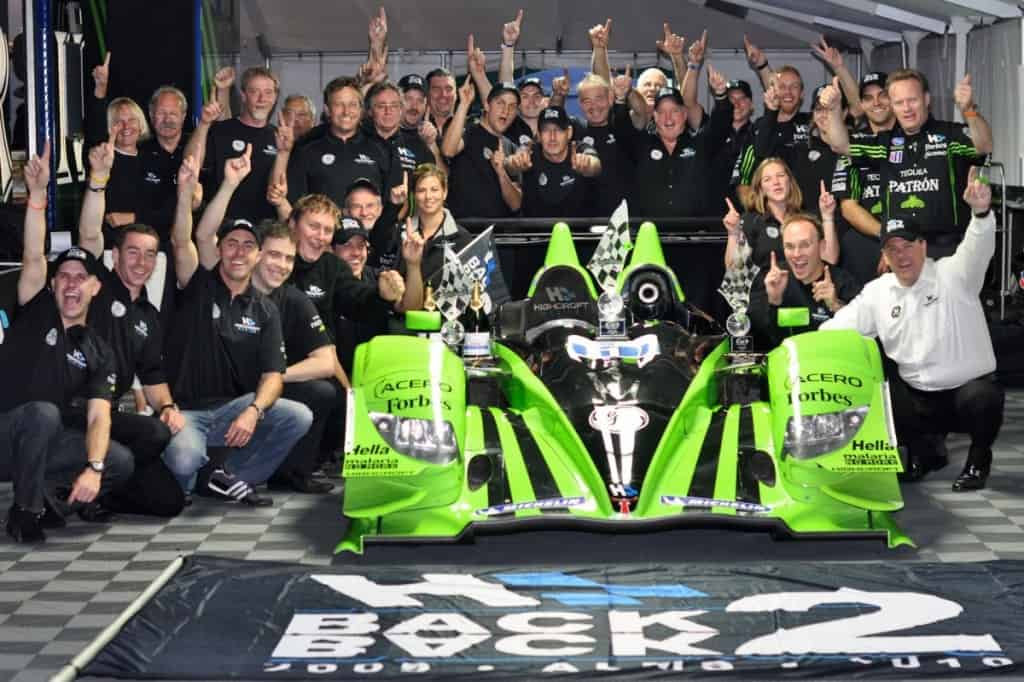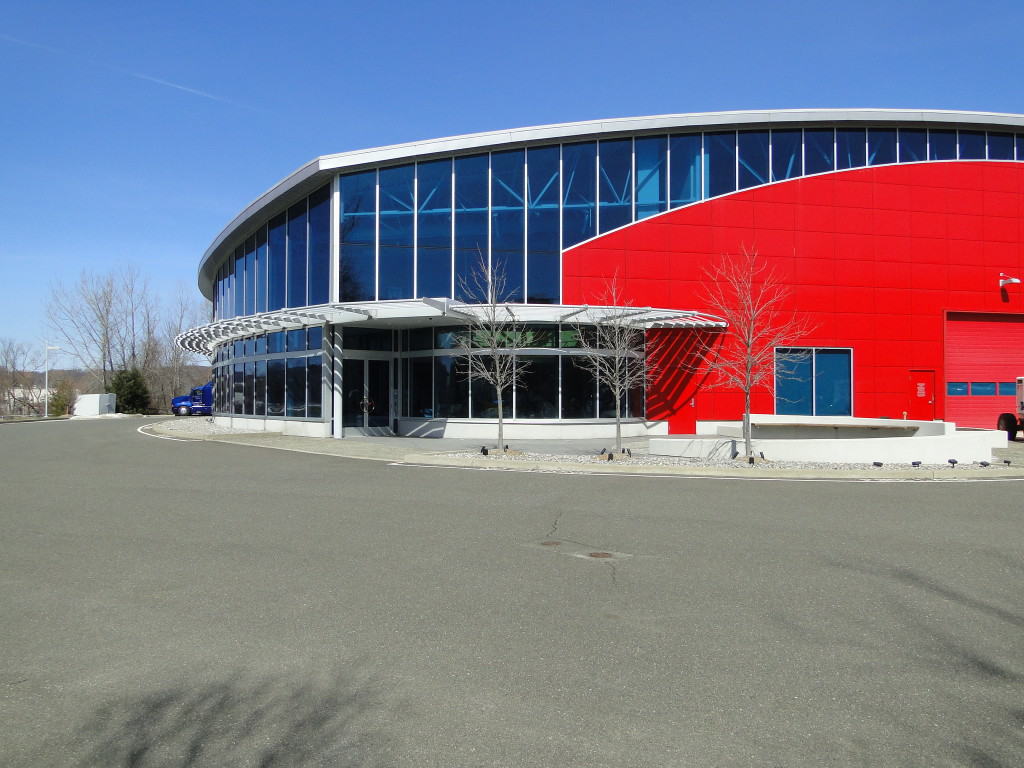If you are not familiar with Highcroft Racing, they are a top notch racing organization lead by owner Duncan Dayton. In both 2009 and 2010, Highcroft Racing was crowned American Le Mans Series (ALMS) champions. Additional information can be found at HighcroftRacing.com .
As one arrives at their 48,000 sq ft facility in Danbury, CT, it’s impossible not to be impressed, which is exactly the response Duncan intended. Duncan is a rarity in today’s world, a true Renaissance man. With training in architecture, (he designed the headquarters himself) a very successful background in the real estate business, (enough to launch Highcroft) and professional level driving talent, he’s still a car guy at heart, and welcomed us personally at the front door. While it may not seem like a big deal to some, that simple fact exemplifies what a class act the team is. We felt like kids in a candy store as we eagerly looked around at the beauty and racing history before us. A vintage Ferrari Dino restored to Concourse standards was Duncan’s first hands on restoration, but you’d never know that it wasn’t done by a shop that has won awards at the Pebble Beach Concourse. His vintage Formula Ford 2000, the Lotus 79 that Mario Andretti drove to the 1978 world championship, and of course the 2010 AMLS LMP2 championship winning racecar….still wearing the scars of it’s last race, combine to form an eclectic bunch. We could have easily spent hours enjoying the showroom itself.
 It wasn’t until the age of 31 that Duncan first sat in a racecar. He quickly fell in love with the sport and excelled as a driver. After winning several prestigious international historic races, Duncan wanted to take it to the next level, so he and his friend Michael Fitzgerald teamed up to race Formula Ford 2000 in professional competition. In 1996 two of Duncan’s friends, including Fitzgerald, broke their backs in open wheel racecar crashes. Thinking about the potential risks associated with open wheel racing caused him to shift his focus to sports car racing. Duncan went on to participate in GrandAM, IMSA and of course, ALMS, where he continued to excel. But it wasn’t enough. In 2006 Duncan opened the doors to Highcroft Racing (named after the neighborhood he grew up in Minneapolis) with a state-of-the-art facility. When asked why he choose to base the shop in CT, Duncan stated this is where he lives and proceeded to talk about some of the local racing heritage. Step one was to purchase a second-hand Lola, and with that, the team participated in ALMS races during the 2006 season with Duncan co-driving. Even with this older car, they proved themselves to be a serious threat giving them the creditability needed to convince Honda to accept a formal bid for manufacturer support. Duncan and friend Danny Sullivan (best known for his 1985 Indy 500 spin and win) spent two long days working on the proposal, which in the end totaled in excess of 40 pages. Duncan recalled how he looked once more at it, and shook his head thinking they’d think it was a bunch of BS. Gut check time: It seemed crazy, but instead they sent a large, nicely framed photo of the Highcroft head quarters building along with a note, “Thanks for the opportunity to submit an RFP, but I’m at a loss for words because I’ve never dealt with a manufacturer before. So to use an old adage, a picture is worth a thousand words. If you like what you see, give us a call.” Honda did just that and shortly thereafter they came and met with Duncan where he sold them on the team’s attention to detail, passion, and commitment.
It wasn’t until the age of 31 that Duncan first sat in a racecar. He quickly fell in love with the sport and excelled as a driver. After winning several prestigious international historic races, Duncan wanted to take it to the next level, so he and his friend Michael Fitzgerald teamed up to race Formula Ford 2000 in professional competition. In 1996 two of Duncan’s friends, including Fitzgerald, broke their backs in open wheel racecar crashes. Thinking about the potential risks associated with open wheel racing caused him to shift his focus to sports car racing. Duncan went on to participate in GrandAM, IMSA and of course, ALMS, where he continued to excel. But it wasn’t enough. In 2006 Duncan opened the doors to Highcroft Racing (named after the neighborhood he grew up in Minneapolis) with a state-of-the-art facility. When asked why he choose to base the shop in CT, Duncan stated this is where he lives and proceeded to talk about some of the local racing heritage. Step one was to purchase a second-hand Lola, and with that, the team participated in ALMS races during the 2006 season with Duncan co-driving. Even with this older car, they proved themselves to be a serious threat giving them the creditability needed to convince Honda to accept a formal bid for manufacturer support. Duncan and friend Danny Sullivan (best known for his 1985 Indy 500 spin and win) spent two long days working on the proposal, which in the end totaled in excess of 40 pages. Duncan recalled how he looked once more at it, and shook his head thinking they’d think it was a bunch of BS. Gut check time: It seemed crazy, but instead they sent a large, nicely framed photo of the Highcroft head quarters building along with a note, “Thanks for the opportunity to submit an RFP, but I’m at a loss for words because I’ve never dealt with a manufacturer before. So to use an old adage, a picture is worth a thousand words. If you like what you see, give us a call.” Honda did just that and shortly thereafter they came and met with Duncan where he sold them on the team’s attention to detail, passion, and commitment.
While we sat in the boardroom listening to this story, Duncan pointed over to the radiator covers. He recounted how he did the same thing during the meeting with Honda and told them that “we couldn’t find anything that looked good enough so we made them ourselves. If you want someone to execute your program at that level of attention to detail, we’re your guys.” (He’s right, the covers were noticed long before he mentioned them, and they, like many other building details, are unique and a cut above.)
A few days later the deal was signed and they were onboard with new Acura ALMS racecars and HPD manufacturer support. Although with Duncan behind the wheel they were turning very competitive lap times, his involvement as team owner and driver was a concern for Honda. In order to truly excel as a team, it was not realistic to both drive and run the organization. Duncan was asked by Honda to be the best he could be as a team owner. That had to have been a bittersweet meeting.
We asked Duncan how difficult it was to make the transition away from driving. Initially while at the track it was a little tough he quickly embraced the challenges and satisfaction of being a team owner. Somewhat ironically, later that summer he broke his neck in a freak pool accident which we imagine in some weird way made being a team owner a bit easier from then on. Duncan did state that he still races vintage cars and actually thinks they are more fun to drive than modern cars. “Newer racecars do more work for you. Traction control, no lift shifting, and telemetry constantly looking at what is happening to the car. The driver doesn’t need to focus on as much. But these (vintage) cars are so much on the edge.”
Turning Your Passion Into a Career
We know that many readers are dying to figure out how to make racing a full time career. It’s something that Dave has personally given great thought to and searched for ways to turn this dream into reality. But how?
Duncan explained that “to be a driver at this caliber, you have to be quick. You need to get through a season and be on the podium frequently without damaging the car. Controlled aggression. Know when not to put yourself in a bad position.” Duncan also talked about how vital it is for the driver to be able to make split-second decisions, and be right on with them. While his drivers assist in making introductions to various contacts they might have who could help the team in the from of sponsorship, Highcroft tries to allow their drivers to focus on driving and their racecraft. This, in today’s motorsports, is uncommon, where even mid-level F1 drivers are arriving partially funded. When it comes time to add a new driver, the team looks at drivers who have a familiarity with tracks the team competes at, experience with this type of racecar, and overall driving history. Duncan feels that they know many of the drivers in the industry and have a good idea of who they would speak with if need be.
While only a few select group of individuals ever make it to this level as a driver, there are other opportunities which exist. At the time of our interview, Highcroft Racing employed 18 full-time, year-round staff but has had as many as 30 full-time team members. Highcroft does not have “fly-ins” (meaning people employed on a part-time basis who just fly to the various events).
In 2009, Scott Sharp was involved in a major crash during a practice session at Road Atlanta, where 90% of the car needed to be completely rebuilt in a matter of 17 hours. Acura air freighted in a new chassis from California. Watching the process was a unique sight to most racing fans, (Jake was there) as the damage and the work level was massive. Duncan explained “There was no panic. We had to think, lay it out, and prepare. After rebuilding the car and completing the Petit Le Mans race, there were three loose nuts on the under tray of the car. Defferan’s team (Gil DeFerran ran the other HPD supported Acura team) had five (these nuts on the under tray are known to come loose). We essentially built the car from scratch. A team of fly-in guys just couldn’t do this.”

We asked Duncan what he looks for and what it takes to have a chance to work with a team like Highcroft Racing. “A person needs to show incredible persistence, commitment, attention to detail, expertise, be confident, and organized. You also need to work your ass off. It’s not just finding the right guys, but finding the right chemistry. It’s like any team. Often it’s better to have a good group than some superstar who’s selfish and wants to be the hero. This is literally like going into battle.”
“On the pit stand, you might have 3 seconds to make a decision whether or not to pit because a yellow is coming out. There is no ‘lets group together and think about it’. The person has got to be able to process everything and assimilate, filter out non-important information, and focus on what’s important very quickly.” And it’s not just the decision which is important. It’s the call to the driver and his ability to work traffic if need be, to be able to get the car to the pits, immediately, or the opportunity to ‘out strategize’ your opposition vanishes. If the radio call is unintelligible, the strategy is lost. Every detail needs to operate flawlessly.
We always thought working on a racing team like Duncan’s would mean some long hours several times during the year, but was a bit surprised with just how intense it is. “There is no off season for racing at this level. If we try to calculate the number of hours it took to win the championship, the team of 30 people literally worked 16 hour days for 1 ½ years.” In addition to Highcroft’s employees, there were many other people working long hours on various projects related to the team’s effort. For example, people at Honda Performance Development (HPD) who provide the engines. Duncan stated that “you have to be able to dedicate your life to it. More than anything else, if you don’t have the passion, forget it. This is not about the money. The headaches, blood, sweat and tears you put into this is beyond what people can comprehend. If you have all of this, you’ll find a way. Eat, breath and sleep it.”
Personnel need to be well rounded on a race team, in ways that aren’t readily apparent. For example, finding the right person to drive the truck. “They’re driving down the road with a couple million dollars worth of equipment in it, the truck needs to arrive at the track spotless, they need to arrive not on time but early, look and act responsibly while on the road, and they certainly can’t ever get road rage. As a driver, they need to get under the truck inspecting it, and be able to service it.” They represent not just Highcroft racing, but the flagship of Acura branding. Everyone throughout the team needs to pay attention to detail and have commitment, even the janitor.

Duncan also discussed the necessity of paying your dues. “We had a couple young engineers come in and they were assigned to ‘lifeing’ systems, which is insanely tedious and pretty boring. But it’s critical to what we do. There are 4,800 parts on the racecar, and every nut and bolt is ‘lifed’ to know exactly what the expected life of parts is. You’ve got to be willing to do whatever it takes.” One of Duncan’s most senior guys on the team is also the guy putting stickers on the car. This could be seen as one of the lowest jobs, but he’ll get the sticker perfect because he knows it’s the sticker / sponsor that is paying his salary. Even as the team owner, Duncan does whatever it takes all the way to sweeping the floors when needed to ensure the operation runs smoothly.
As you might imagine, these jobs are not normally going to appear on a typical job hunting website. In order to get in the door, a candidate will need to rely heavily on networking. One should begin by offering assistance to teams in lesser levels of the sport, such as SCCA, GrandAM, or anywhere a newcomer to the sport can learn and meet people. Once up to speed, always ask for new responsibilities, then take more and more on.
Attention to Detail
We’ve already talked about the importance of attention to detail, but Duncan really made us think more about how critical it really is. “A three cent O-ring could get crimped, cause a leak, then cause other major problems.” He termed it as “finger trouble” where small items can be missed such as an electrical connector not being properly connected. “When out on the track, these types of things can cost a team a championship.” A tour of the transporter was illustrative. In it are banks upon banks of cabinets and drawers of fastidiously organized supplies. One drawer was opened to reveal hundreds of mil spec electrical connectors used in the teams radio system. Backups for backups. If you can’t communicate, you can’t capitalize on strategy, and you won’t win.
He went on with another example of just how detail oriented their team is. Take for example choosing a note pad. There are hundreds of decisions that go along with this. What size should the paper be? Should it be blank, have lines, or graphs? Should the pad be spiral bound then by the top or on the side? He went on with other factors related to the decision and explained how seemingly inconsequential items such as a pad of paper factors into the team’s success. While a pad of paper won’t make or break a team, it demonstrated how just far and how much thought is given to everything. To truly succeed at this level, this is the amount of attention to detail it takes.

